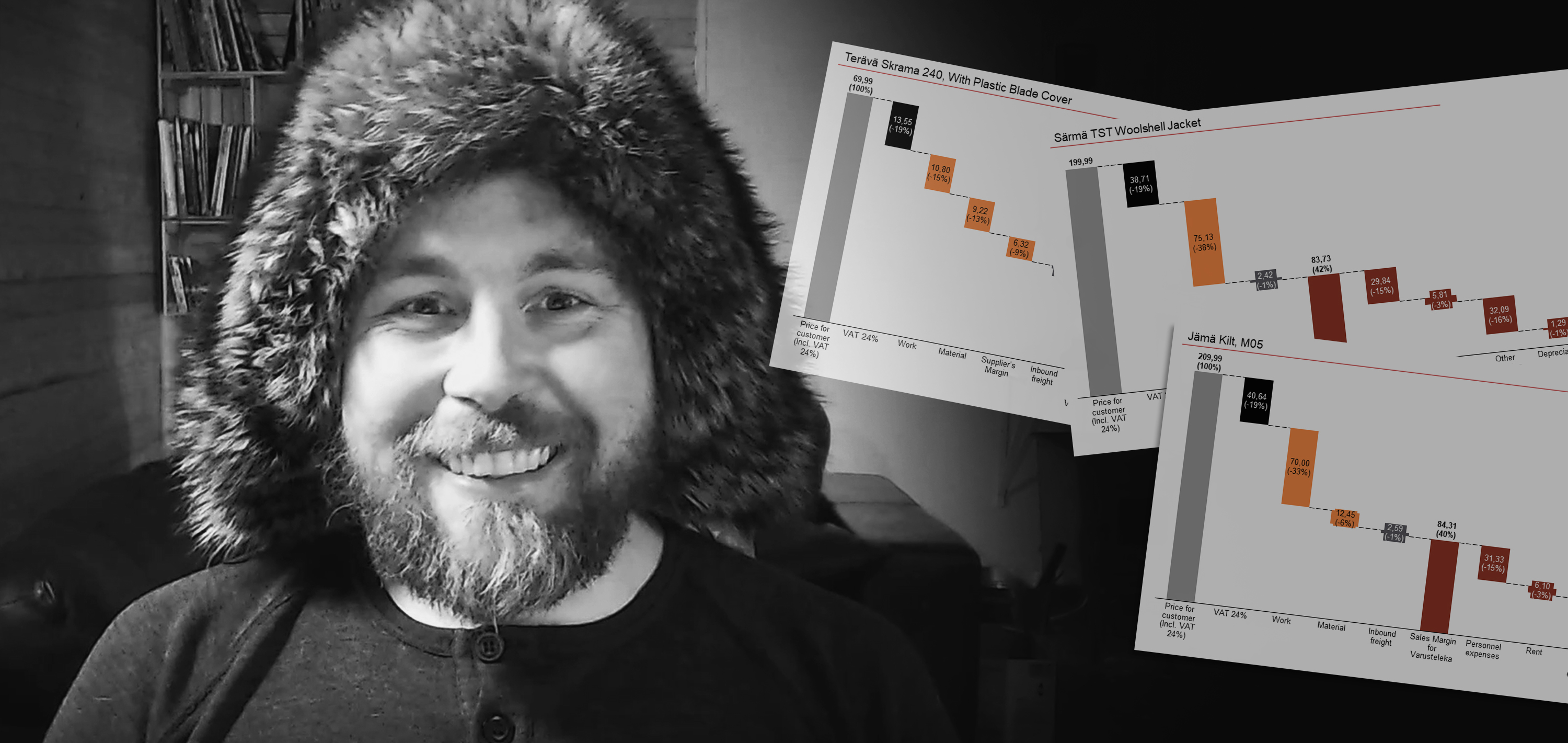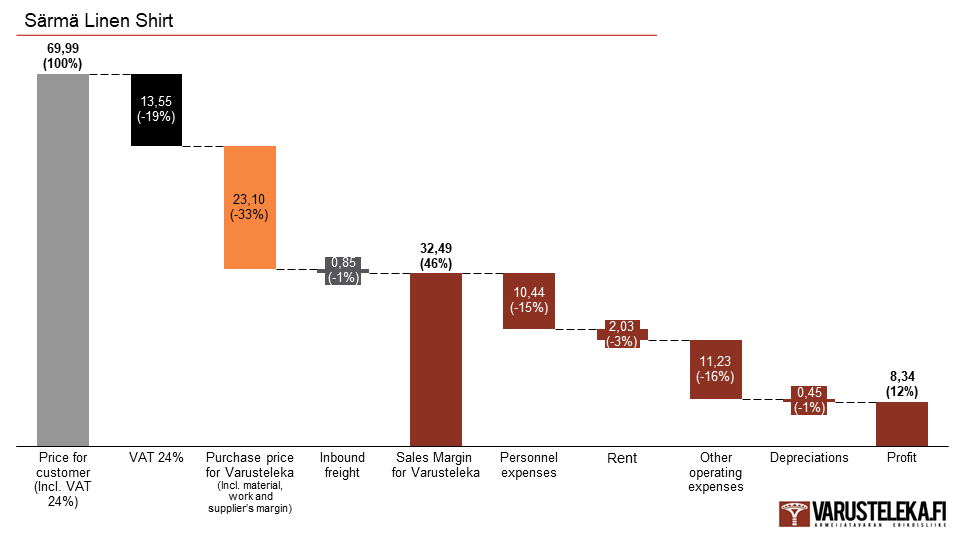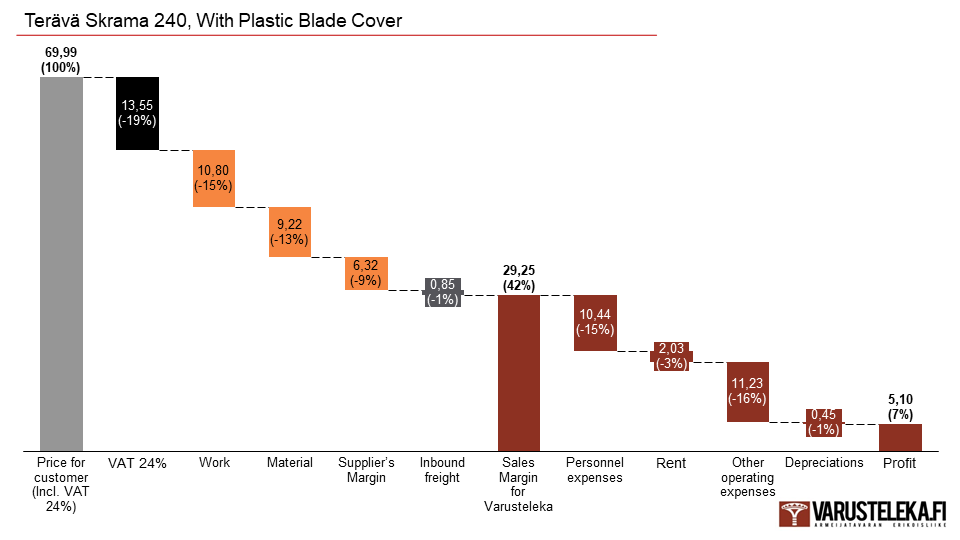
Sales margin and why everything costs
Sales margin and why everything costs

The author Valtteri Lindholm is the founder, owner, and the Chairman of the Board of Varusteleka.
Not gonna give you any discounts
It’s the fucking Black Friday all over again. No, we’re not going to discount anything, not this time either. Instead here’s a lecture about the profit margin.
Like I have said before, Black Friday discounts, in general, don’t mean that you get the good stuff you intend to buy at a cheaper price, i.e. that the shop would lower its profit margins. No, most Black Friday “discounts'' are for stuff that shops specifically get for the occasion. They first sell them with such a profit margin that nobody buys them, and when Black Friday comes, they give a “discount” that lowers the price to a normal profit margin, and people literally buy their bullshit.
Everything has a price
Maybe the biggest thing being an entrepreneur has taught me is how much everything costs and that there are a lot of all sorts of costs out there. The company, community, and the state all need different kinds of things to function and each and every one of those costs money. There are so many of these things that when you run a bit more complicated company, it becomes very difficult to estimate those costs beforehand. So, you actually achieve better results by trying things out in practice to see whether you can make it work.
I learned this almost immediately after high school. However, even many adults don’t yet understand this. Gross profit margin isn’t direct profit. At almost all companies, a large part of this money is spent before the company can pay the entrepreneur’s salary or mark anything as the company’s net profit. This article is something I would have wanted to read when I was in junior high or high school at the latest.
50% gross profit margin is good in the clothing business
When I founded Varusteleka, I was told about the “Lallukka margin”. According to (a bit exaggerated) legend, one of the most significant tradesmen in Finland, Juho Lallukka, started his business career as an uneducated young boy in an abandoned threshing cabin. When people asked about his gross profit margin, he answered: “When I buy with a buck, I sell it with two.” A 50% gross profit margin after taxes was also the rough guideline at Varusteleka in the early days and as a matter of fact still is. In the clothing business, the gross profit margin is often 60-70%, yet very few companies can remain profitable. For example, H&M, the arch nemesis of Varusteleka, when you look at the operating principles, “only” made a 7% profit.

Here are a few examples of where all that money goes. This is by no means a complete list. I just started writing it in the order the things popped into my mind and stopped early to leave room for other stuff.
- VAT
- Rent
- Electricity and water
- Cleaning
- Computer rental costs
- Printer rental and other costs
- Phones
- Phone subscriptions
- Internet subscriptions
- Server costs
- Store shelves and their maintenance/repair/replacement
- Rental fees of the credit card readers and other equipment used in the store
- Bar equipment rental and service costs
- License fees
- The introductory and monthly costs of the ERP system and the online store
- Monthly fees of the warehouse management system
- Monthly fees of the customer service system
- Monthly fees of the normal office software
- Monthly fees of the reporting software
- Monthly fees of the accounting software
- Monthly fees of the AV software
- Rental fees of the warehouse scanning equipment
- Rental fees of the automated storage and retrieval systems
- Warehouse shelf rental
- Cardboard boxes and other packaging material
- Forklift truck rental
- Waste management costs
- Wages, indirect wage costs, and taxes
- Cameras and their accessories
- Camera lights
- Microphones and similar accessories
- Props
- Office furniture
- Kitchen renovation at the office
- Legal fees
- Trademark registration fees
- Shipping costs from the factories to us
- Shipping costs from us to customers
- Shipping costs of returned items
- Shipping costs and refunds of recalls
- Pop-up container store and its decoration
- Container store transportation costs
- Travel costs
- Physical marketing material
- Google fees
- Facebook fees
- Criteo fees
- Costs regarding other visibility
- Prototypes, test samples and their freight
You can live on a smaller profit margin but not in this business
Some other companies might tell you mockingly that they would be filthy rich with a 50% gross profit margin. Well, each field is different. When you sell clothes to consumers, it is done individually. You must convince each consumer separately that they should get exactly this piece of clothing from us. And each of these (usually less than 100 euro) orders must be processed individually. If we were a wholesale company, we could save a ton of money because we could shove a hundred times more stuff in the same box.
The gross margin in the grocery trade is usually said to be around 30 %. However, the grocery business is fairly straightforward because the same customer visits the store almost daily, and the main question is which store they will choose. Also, for example, electronics are often sold with a low gross margin, because the products are expensive, and the seller might not have to pay for the product before the customer has ordered it. The same goes for us when it comes to more expensive products: The boots that cost over hundred euros definitely don’t yield a 50% gross margin, And when one Leatherman was stolen from the store, we had to sell ten more to make up for the stolen one.

Guess what is the biggest cost in this photo: Särmä Bathrobe, the shower room rent, the shampoo bottle, or the man on the floor?
Varusteleka’s cost structure
At the end of this article, we display the cost structure of a few of our products graphically. So yes, instead of ridiculous Black Friday offers, we show you how much money we make without giving any discounts whatsoever!
The cost structure of these products has been calculated using the annual costs of the whole company because we didn’t have the resources to calculate every single thing separately for each product for just this article. However, for some of the products, we were able to calculate the labor costs of that exact product.
As you can see, the biggest chunk goes to the VAT, 19%. The VAT is calculated from the product before taxes, therefore the total amount isn’t the same as the VAT percentage.
The largest cost after the VAT is the personnel. In addition to the wages, this also includes social security costs and taxes. Everybody should remember that when you get that payslip, the additional costs for the employer are at least one third on top of that. And it only stays that low if the company can handle the HR management exceptionally smoothly and doesn’t spend a cent on the wellbeing of the employees.
The other business-related expenses contain the majority of the things I listed earlier on. There’s however one specific cost that perhaps should have been mentioned separately. The freight costs of the sold items. Nine per cent of our turnover (without taxes) is spent on sending the goods to the customers. And it is worth mentioning that we charge a lot less for the shipping than it actually cost to ship the stuff to customers.
When you look at those numbers, the very last one is our actual profit margin. For example, in Jämä M05 Kilt, it’s 11.83 euros. I’ve heard people bitch and moan that it’s ridiculous to put ten euros on top of the 200 euro price tag. Well, if we were to give a Black Friday discount of whopping 5%, that’d practically eat the whole of our profit. Not gonna happen.
When you buy from Varusteleka, you can trust that you’ll always get a good deal - we don’t up our prices to give discounts, and so it never makes sense to wait for one. Practically the only time we discount something is when customers don’t like the product and it doesn’t sell, like those disgusting Serbian sleeping bags, for instance. When you see that discount, it means the product isn’t coming back to stock.



